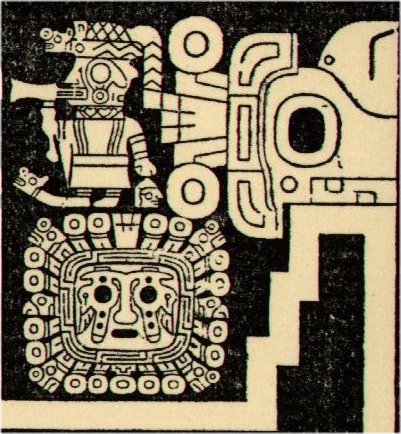4. Back to Botein. If we count from the empty hands in Gb8-14 to the next occurrence of this type of sign, disregarding the negation of it in Gb8-26, then we will find there are 13 + 19 = 32 days (glyphs) up to and including Ga1-14:
The last glyph of this kind is tagata in Gb5-21, which arrives 360 days later:
From Acamar (Gb8-10) to kava in Gb5-25 there 21 + 379 = 400 days. I will for the moment not try to work any more with this type of upraised hands, but hands are important and we need to make some progress with the hand signs, although there are several variants of them. Glyph number 14 in a line seems to carry special importance. Here the strange Botein figure is looking backwards. It ought to indicate that he stands 'inside the mirror' (looking-glass), i.e. a reversal has just taken place. The 'nostril' of Cetus (Menkar) and the head of Medusa (Algol) are signs of similar portent, a great change has just passed. The Sea Monster has stretched his head and forepaws up onto the 'beach'. The head of the mortal Gorgon has been cut off and her 'manu rere' (Musca) has fled:
From puo ('hilled up') to puo at the end of side b there are 22 glyphs, the cycle is closed. "Botein is from Al Butain, the dual of Al Batn, the Belly [cfr Batein Kaitos], probably from some early figuring, for in modern maps the star lies on the tail." (Allen) The plural form suggests Venus rather than Saturn. She is 'hilled up' twice a year but Saturn never. Maybe the absence of Venus in the night sky was interpreted as (magically) connected to the 'death' of Sun at winter solstice. The head which must come off to make him return again could be the dark head of Venus. In the pictures on the Gateway of the Sun we can imagine the head of Medusa in the left hand of the figure who could be Perseus:
In the Babylonian zodiac the Hired Man has his tail where the 2nd quarter is beginning. At the same time the Old Man has a globular object in his left hand and below him are 6 + 1 stars (presumably the Pleiades) and a waxing Moon crescent:
It is hard to avoid seeing the Old Man as Perseus and his round object as the head of Medusa. The symbol of Venus and the Rainbow indicates Sun is returning. According to the Mul-Apin text (cfr at Metallah) the Old Man is the 3rd 'star' on the path of Enlil and its name is Enmesharra. The Hired Man is the 4th 'star' on the path of Anu and named Dumuzi. Thus we can guess that Enmesharra is Perseus and that Dumuzi is Aries. Perseus is coming down on the path of Enlil, but Aries is on the ecliptic. As to Dumuzi (the Ram) we had better read the following from Wikipedia: "Later poems and hymns of praise to Dumuzid [the Shepherd, who in the Sumerian King List was the 5th predynastic king before the deluge and who ruled for 36,000 years] indicate that he was later considered a deity, a precursor of the Babylonian god Tammuz. In Tablet 6 of the Standard Babylonian Epic of Gilgamesh, Gilgamesh rebuffs Ishtar (Inanna), reminding her that she had struck Tammuz (Dumuzid), 'the lover of [her] youth', decreeing that he should 'keep weeping year after year'. Pictured as a bird with a broken wing (an allallu-bird, possibly a European or Indian Roller), Dumuzid now 'stays in the woods crying My wing!' (Tablet 6,ii,11-15). Another possible identification for this bird is the Northern or Red-wattled Lapwing, both of which species are well known for their distraction displays where a wing is dragged on the ground as if broken in order to divert a potential predator from the lapwing's nest. The mournful two-note call of these birds also evokes the Akkadian kappi, 'My wing!'. In a chart of antediluvian generations in Babylonian and Biblical traditions, William Wolfgang Hallo associates Dumuzid with the composite half-man, half-fish counselor or culture hero (Apkallu) An-Enlilda, and suggests an equivalence between Dumuzid and Enoch in the Sethite Genealogy given in Genesis chapter 5." Cfr at Kara Etahi where I have suggested the bird with only one wing refers to Antares. The death of Julius Caesar (caused by Junius Brutus) comes to mind, it occurred in the middle of March and the birth month of Julius was the 5th in the calendar, the month which became July in honour of him. The calendar must have began in March, otherwise July could not have been the 5th month. But the month Tammuz is also the name for the month of July in the Gregorian calendar in Arabic, Syriac, and Turkish ('Temmuz') according to Wikipedia, and: "Tammuz was a month in the Babylonian calendar, named for one of the main Babylonian gods, Tammuz (Sumerian: Dumuzid, 'son of life'). Many different calendar systems have since adopted Tammuz to refer to a month in the summer season." The 'son of life' must of course die because otherwise he would never be alive. Life is like light an impossible concept without its opposite, the 'shadow'. The King, shining in his splendour, must therefore die, or at least someone must die. In my preliminary glyph type dictionary this is the summary page for the rona glyph type:
I am no longer so sure about the details, for instance the statements that spring respectively autumn have ended, there are other possible seasons. And the number games are plenty, e.g. seems 11 * 3 = 33 quite possible (in Gb1-13) and 29 seems more probable than 39. The end of Sun could be defined by 243 - 29 = 214 (leaving 354 - 214 = 140 = 10 fortnights to the season of absent Sun. |
















